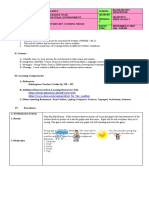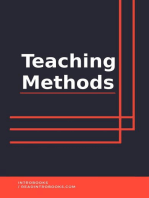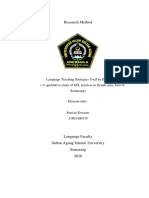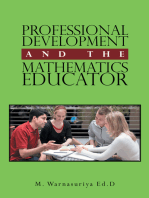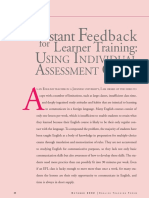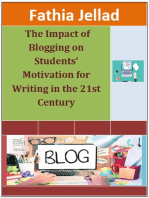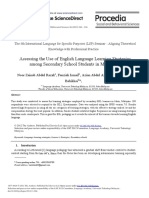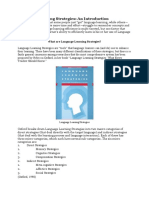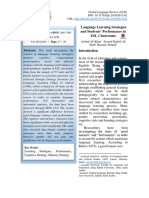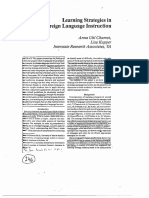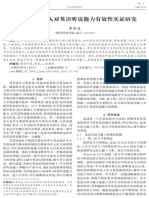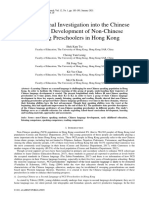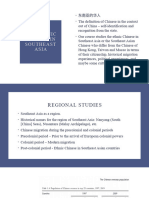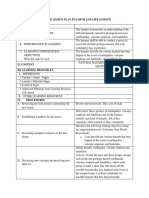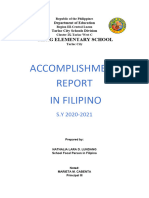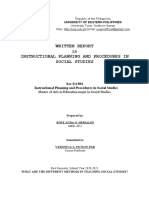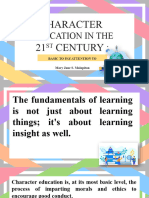Learning Strategies Used by The Students in Performance Assessment in EFL Classroom
Uploaded by
Khor Huey KeeLearning Strategies Used by The Students in Performance Assessment in EFL Classroom
Uploaded by
Khor Huey KeeSee discussions, stats, and author profiles for this publication at: https://www.researchgate.
net/publication/331127395
Learning Strategies Used by the Students in Performance Assessment in EFL
Classroom
Article in Humaniora · December 2018
DOI: 10.21512/humaniora.v9i3.5025
CITATIONS READS
4 4,672
3 authors, including:
Sumardi Sumardi
Universitas Sebelas Maret
94 PUBLICATIONS 486 CITATIONS
SEE PROFILE
All content following this page was uploaded by Sumardi Sumardi on 01 April 2020.
The user has requested enhancement of the downloaded file.
LEARNING STRATEGIES USED BY THE STUDENTS IN
PERFORMANCE ASSESSMENT IN EFL CLASSROOM
Ida Dwi Safitri1; Sumardi2; Slamet Supriyadi3
1,2,3
Department of English Education, Faculty of Teacher Training and Education; Sebelas Maret University
Jl. Ir. Sutami 36 A, Surakarta 57126, Indonesia
1
[email protected]; [email protected]; [email protected]
ABSTRACT
This research aimed to discuss performance assessment in Indonesia as well as learning strategies used
by the students in its implementation. A qualitative case study was applied in this research. The researchers
spread questionnaire and conducted an in-depth interview to derive the data. From the discussion, some
conclusions are derived. First, performance assessment has advantages in EFL such as promoting high order
thinking skill, making students familiar with various contexts of language use, presenting tasks which allow
students to apply their knowledge and skills from several learning targets, using clearly defined criteria to
evaluate how well the student has achieved this application, and increasing students’ motivation. However, there
are disadvantages from this kind of assessment such as time-consuming, the assessment tends to be subjective,
requiring intensive training for raters, and it may intimidate students. Furthermore, the students apply almost all
of the learning strategies as follows meta-cognitive, cognitive, social, and affective strategies. The contribution
offered by this research is to give evidence prevailing to Indonesian EFL learning. The teacher can support or
provide students’ need by knowing their students’ strategies in learning. However, the students can adjust their
learning strategies when performance assessment is implemented.
Keywords: assessment, performance assessment, integrated performance assessment, learning strategies, EFL
INTRODUCTION
Indonesian EFL students spend at least six years studying English, that is, in junior and senior
high school. Most higher level institutions in the country also include English as a primary course in
the first semester. However, some argue that English teaching and learning system in Indonesia fails to
make the learners master the target language (Djihadi, 2010). English teaching and learning in the
country mostly gives rote learning – a term coined by Ausubel, Novak, and Hanesian (1968) which
refers to negative washback. There are at least four characteristics of rote learning (Ausubel, Novak, &
Hanesian, 1968). First, the learning is arbitrary or unstructured that it cannot serve an adequate link
between learners’ new knowledge and cognitive structure. Secondly, there is no effort to combine new
and existing knowledge. Third, the learning has no connection with students’ actual experience so that
it is harder for them to get the gist of what they are learning. Additionally, there is no commitment to
relate new knowledge to prior learning.
However, Ausubel, Novak, and Hanesian’s criteria (1968) only cover cognitive aspect and
somewhat deemphasize meta-cognitive one. Djihadi (2010) has stated that nowadays most Indonesian
students learn about English, not how to use English. It results in uncompetitive graduates in
employment. It may disadvantage Indonesian economic position in the free trade era where people
have to compete with global citizens. English as an international language plays an important role in
globalization as a means of communication. Without adequate mastery of using English, Indonesian
would face difficulty in making their way into a suitable career path.
Learning Strategies Used …..(Ida Dwi Safitri et al.) 291
Government’s involvement through curriculum regulation affects much in English teaching
and learning which lead to Indonesian students’ competency. As cited in Lie (2007), English is
included as a part of teaching and learning project in 1975. In this phase up to 1994 curriculum era,
cognitivism dominates the style of teaching and learning, even though one of its visions is to integrate
cognitive with affective and psychomotor aspects. Then in curriculum 2004, Indonesian government
pushes educators to implement the three aspects fully. However, its actual implementation is too
simplistic. The strict standard of national examination as the only way to graduate makes teachers
refer back to the old-fashioned way of teaching, that is, teaching about English.
The latest curriculum seems to give a shed of light in English teaching and learning. Based on
constructivism theory, the 2013 curriculum is plotted to emphasize high-order thinking skill. Students
and teachers are expected to be more active and engaged during their classroom interaction. Therefore,
performance assessment is proposed. As a part of the alternative assessment, performance assessment
has greater washback. Brown (2004) implies that it is usually related to what the students may use in
the future. However, its impracticality and low reliability make some teachers reluctant to engage in it
fully. As postulated by Brown (2004), performance assessment in language learning ideally requires
integration with other subjects.
In Indonesia, performance assessment may not meet the idealized requirement because of
several reasons. The first reason is about time allocation. The approximately 90 minutes a week for
English cannot maximally contribute to the expected positive washback. The second is that English
teachers may not have adequate knowledge to combine English with other subjects, for example,
physics, chemistry, history, and so on. Furthermore, the final assessment mostly deals with discrete
formats which result in a general aspect of performance assessment, not integrated into certain
subjects. Therefore, this research would like to elaborate on performance assessment and the strategies
that the students use when it is implemented.
Assessment is, “An ongoing process that encompasses a much wider ___domain” (Brown, 2004).
The test focuses on some particular task; however, assessment is more general; not only a particular
task but also teaching including test (Sah, 2012). By doing the assessment, the teacher can assess
students and provide feedback during teaching because it affects student learning (Buyukkarci, 2014).
Assessment is part of the teaching and learning setting to develop the teachers’ skills in teaching and
students’ skills in learning (Parkes, 2010). Some researchers have declared that in the learning process,
assessment is a process of the teacher gather information related to the importance of variables in
order to improve their process in teaching hence it can improve the students’ achievement
(Salandanan, 2012). Teachers should gather different information in different forms at different times
to make their decisions about students’ learning. A good assessment can help students become more
effective self-directed learners. Burhan (2009) states that the assessment does not include in decision
making and reporting. He is esteemed that assessment is focusing on data gathering and placing a
value on something. Nunan (2004) says that assessment is the subcomponent of evaluation that
consists of the techniques and procedures to collect information related to what the students can do
and cannot do.
In performance assessment, “The students evaluate and solve complex problems, conduct
research, write extensively, and demonstrate their learning projects, papers, and exhibitions that have
proven key to motivating students and attaining high levels of learning in redesigned high schools”
(Darling-Hammond, 2006). It means that in performance assessment by the teacher gives a chance to
students to demonstrate their knowledge. Bass, Magone, and Glaser (2002) give the same
consideration about performance assessment. They define that in performance assessment to the
students, especially with different language backgrounds, allow engaging in cognitively complex
activities such as generating strategies, monitoring work, analyzing information, and applying
reasoning skills. According to Arhin (2015), performance assessment is the type of assessment which
requires the students to master specific skills by performing their capability.
292 HUMANIORA Vol. 9 No. 3 November 2018: 291-303
Linn and Burton (1994) explain that performance assessment is an assessment that reflects
good instructional activities that are often thought to be more engaging for students. In performance
assessment, the teacher not only gives students a chance to show their knowledge but also discloses
more in-depth information on students’ academic needs. Parker, Louie, and O’Dwyer (2009) indicate
that performance assessment aims to judge the students’ competency level in doing reading/language
arts, science, and mathematics. This statement clarifies that assessment can monitor students’
processing skills while stimulating learning activities. It can help teachers decide where to begin
instruction or determine which students need special attention.
Furthermore, Abedi (2010) indicates that performance assessments can be less affected by
unnecessary linguistic complexity for two reasons, such as language is often not the only medium of
presenting an assessment task and students have access to these physical materials as they formulate
assessment responses thereby reducing reliance on language. According to Meisels et al. (2010),
performance assessment is better than other assessment because it is designed to evaluate
individualized development. Additionally, teachers are allowed to evaluate students’ progress by
obtaining information from ongoing classroom interactions. Based on these definitions, it can be
concluded that performance assessment is the judgments of the teacher about students’ level of
competency through their knowledge in evaluating and solve the problem that is allowing them to
engage in cognitively complex activities such as generating strategies, monitoring work, analyzing
information, and applying reasoning skill.
Integrated Performance Assessment (IPA) is, “A classroom-based assessment model that can
be used for evaluating students’ language use in the three communicative modes (interpersonal,
interpretive, and presentational) that correspond to the communication standards that appear in the
national standards for foreign language learning” (Tedick & Cammarata, 2006). In this assessment, the
teacher provides an opportunity for students to demonstrate their knowledge and receive feedback.
The IPA provides a great tool to guide teachers in the difficult process of selecting authentic and
appropriate texts. For the interpretive task, it is listening/viewing or reading, the selection of authentic
texts must vary depending on what needs to be assessed at where the specific level of the students.
IPA is focused on the creation of authentic tasks for students to engage in classroom activities (Tedick
& Cammarata, 2006). The IPA model offers an opportunity for language teachers to create open-ended
tasks that allow students to be very creative.
Furthermore, Adair-Hauck, Glisan, and Troyan (2014) explain that IPA is a summative
assessment currently utilized to effectively assess language learners’ progress in meeting the National
Standards for Foreign Language learning in the 21st century. The purpose of IPA is to provide a real-
world context for assessing real-world competence in the five goal areas (which are much broader than
just linguistic proficiency) by asking the learner to complete an authentic task. Based on the definition,
it can be concluded that integrated performance assessment is a classroom-based assessment model
that can be used for evaluating students’ language use in the three communicative modes
(interpersonal, interpretive, and presentational) to effectively assess language learners’ progress in
meeting the National Standards for Foreign Language learning in the 21st century.
Davis-Wiley (2016) explains that based on the modes of communication, integrated
performance assessment reflects as the following: (1) interpersonal is active negotiation of meaning
among individuals, participants observe and monitor one another to see how their meanings and
intentions are being communicated. (2) Interpretive is the interpretation of what the author, speaker, or
producer wants the receiver of the message to understand; one-way communication with no recourse
to the active negotiation of meaning with the writer, speaker, or producer. (3) Presentational is the
creation of messages to inform, explain, persuade, or narrate. It is one-way communication that
intended to facilitate interpretation by members of the other culture where no direct opportunity for the
active negotiation of meaning between members of the two cultures exists.
Learning Strategies Used …..(Ida Dwi Safitri et al.) 293
Considering the performance assessment in the EFL classroom, the students need to pay
attention in order to be successful when the teacher applies it. Thus, they should adjust their learning
strategies to achieve their goals. Learning strategies are, “Any sets of operations, steps, plans, routines
used by the learners to facilitate the obtaining, storage, retrieval, and use of information” (Rubin,
1987). According to Scarcella and Oxford (1992), learning strategies are, “Specific actions, behaviors,
steps, or techniques (such as seeking out conversation partners or giving oneself encouragement to
tackle a difficult language task) used by students to enhance their own learning.” Additionally, Cohen
(1998) states that language learning strategies are the steps taken by the students in order to enhance
their language learning through, “The storage, retention, recall, and application of information about
that language.” Oxford (1990) believes that learning strategies make learning, “Easier, faster, more
enjoyable, more self-directed, more effective, and more transferable to new situations.”
Some researchers have classified language learning strategies, such as O’Malley and Chamot
(1990), Rubin (1987) and Oxford (1990). O’Malley and Chamot (1990) identify the three categories of
language learning strategies, namely; (1) meta-cognitive strategies: a term to express executive
function; (2) cognitive strategies: manipulation of the learning material; and (3) social/affective
strategies: social-mediating activity and transacting with others. Meta-cognitive strategies consist of
planning, thinking, monitoring, and evaluating. The important activities in cognitive strategies are
repetition, resourcing, grouping, note taking, imagery, recombination, deduction, and auditory
representation. The main activities in social/affective strategies are cooperative, the question for
clarification, and self-talk.
Rubin (1987) classifies three types of strategies used by learners, such as learning strategies,
communicative strategies, and social strategies. There are two main types of learning strategies;
cognitive learning strategies and meta-cognitive learning strategies. The cognitive learning strategy is
the steps used in learning that requires direct analysis, transformation, or synthesis of learning
materials. It is identified into clarification/verification, guessing/inductive-inference, deductive-
reasoning, practice, memorization, and monitoring. However, meta-cognitive learning strategies are
used to oversee or self-direct language learning that involves various processes, such as planning,
prioritizing, setting goals, and self-management.
Furthermore, Oxford (1990) divides language learning strategies into direct and indirect.
There are three categories in the direct strategy; they are a memory that consists of laying things out,
making the association, and reviewing; cognitive that consists of transforming or manipulating target
language by analyzing, summarizing, and repeating; and compensation that consists of guessing the
meaning of the target language. However, the types of indirect strategies, such as meta-cognitive that
helps students to organize their learning that consist of planning, self-evaluating, paying attention, and
monitoring; affective that helps students to deal with their own motivation, attitudes, and emotion that
consist of self-encouragement, self-reward, and so on; and social strategies that help the students learn
the language through interactions.
This research uses O’Malley and Chamot (1990) classifications of learning strategy, they are;
(1) meta-cognitive strategy: selective attention, planning, monitoring, and evaluating learning activity;
(2) cognitive strategy: rehearsal, organization, inference, summarizing, reducing, imagery, transfer,
and elaboration; and (3) social/affective strategies: cooperative, questioning for clarification, and self-
talk. There are some conditions that make a strategy positive and helpful for the students that the
strategy and the task relate well to each other, the strategy fits the students’ learning style, and the
strategy can be used by the students effectively (Oxford, 1990). There are some factors that contribute
to the choice of learning strategies used by the learners. According to Liang (2009), there are four
factors in strategy choice; they are learner factor that related to learners’ thought, language learning
styles, ages, gender, and students’ motivation; a situational factor that consists of setting and task type;
academic factor; and cultural background. Furthermore, Nambiar (2009) believes that some factors
294 HUMANIORA Vol. 9 No. 3 November 2018: 291-303
that influence the choice of learning strategies; learning environment, proficiency, ethnicity, age,
gender, learning style, motivation, and beliefs.
According to the previous research conducted by Parkes (2010), performance assessment can
promote good communication, developing a willingness to embrace new methodologies, and
ultimately testing and refining the effectiveness in the teaching and learning setting. Furthermore, the
learning strategies used by the students are needed to be discussed since it can be used as a reference
for the students and the teachers to fulfill students’ need in the academic field. Furthermore, previous
research conducted by Shi (2017) has stated that strategy instructions or learning strategy can enhance
learners’ self-efficacy and autonomous learning and help learners to take responsibility for their own
learning. Based on the discussion above, the researchers believe that this research is important and
needs to be explored more.
METHODS
This research is conducted to investigate the advantage and disadvantage of performance
assessment and the learning strategies used by the students when it is implemented in Indonesia. A
qualitative case study is used in this research. Yin (2014) informs that a case study is an empirical
inquiry to investigate a contemporary phenomenon in a real-life context. The goal of qualitative
research is to explore a complex phenomenon that cannot be done qualitatively or difficult to measure
qualitatively (Curry, Nembhard, & Bradley, 2009). There are three educational case study, namely
theory seeking and theory-testing case study, story-telling and picture drawing case studies, and
evaluating case studies (Bassey, 1999). The qualitative descriptive method with purposive sampling is
used in this research.
The participants of this research are the eleventh-grade students of SMA N 2 Surakarta at class
XI IPA 2 in the academic year of 2018/2019. The research is conducted in this school because it is one
of the favorite schools in Surakarta, Central Java, Indonesia. The students are involved in this research
as the respondents to get some additional information regarding the learning strategies used by them in
EFL classroom. The advantages and disadvantages of performance assessment are taken by
interviewing the English teacher who applies it to the classroom.
This research aims to investigate the advantages and disadvantages of performance assessment
and the learning strategies used by the students when it is applied in EFL classroom. This research
uses the qualitative method with a case study as a research design. The researchers spread
questionnaires to 29 respondents at class XI IPA 2 in order to know the learning strategies used by
them when performance assessment is applied. To support the questionnaire data, three students are
interviewed. Moreover, the teacher is interviewed to get information related to the advantages and
disadvantages of performance assessment.
The next method is analyzing the data. Ary et al. (2010) have stated that data analysis is the
main part of qualitative research. It is absolutely important to find the result of the research in order to
make sure whether the research has accurate findings or not. The researchers use Miles and
Huberman’s (1994) data analysis model to analyze this research; they are data reduction, data display,
and conclusion.
Learning Strategies Used …..(Ida Dwi Safitri et al.) 295
RESULTS AND DISCUSSIONS
Performance assessment is seen to enhance skills which are meaningful for students in the
scope of practical use, especially in professional communication. After conducting an interview with
the teacher, the teacher argues that performance assessment has many advantages in teaching and
learning activities. The transcript below represents the teacher’s perception related to the advantages
of performance assessment.
“Performance assessment is very useful in teaching and learning activities. It does
not only promote students’ high order thinking skill but also helps students to know
the various contexts of language use. The tasks given to the students can help them
to apply their knowledge and skill from several learning targets. Additionally, some
criterions of performance assessment can be used to evaluate students’ learning. It
can motivate students to learn more and support them to face challenging situations.
Performance assessment can give information that is needed by the students that
helps the students to adjust their learning strategies in order to meet their own need.
For example, some students prefer to change their learning strategy or learning
behavior because it does not provide their need.”
Interview, 27th September 2018
From the data interview, it can be seen that the advantages of performance assessment in EFL
are promoting high order thinking skill, making students familiar with various contexts of language
use, presenting tasks which allow students to apply their knowledge and skills from several learning
targets, using clearly defined criteria to evaluate how well the student has achieved this application,
increasing students’ motivation and help students to adjust their learning strategies. It means that the
teacher believes that performance assessments are a powerful and useful alternative in teaching
learning activities because these can engage students in demonstrating their knowledge in the content-
based area. These are in line with Nitko and Brookhart’s (2007) statement that performance
assessment, “Presents a task requiring students to do an activity that requires applying their knowledge
and skills from several learning targets and uses clearly defined criteria to evaluate how well the
student has achieved this application.”
Additionally, the teacher says that the outcomes of performance assessments can increase the
level of students’ motivation and support their academic to face challenging situations in taking
standardized achievement. These assessments also supply more in-depth information on academic
needs that help the students to adjust their learning strategies in order to meet their own need. It is in
line with Firestone, Mayrowetz, and Fairman’s (1998) explanation that, “Performance-based
assessment can change specific behaviors and procedures in the classroom more easily than the
general paradigm for teaching a subject.” It means that performance assessments are potential tools for
evaluating teachers and students’ competence and supporting their needed changes in education.
However, there are some disadvantages of performance assessment that are represented in the
transcript.
“Of course, there are some disadvantages of performance assessment. It spends
more time because in implementing performance assessment, each student is asked
to collect the information and share their idea by performing it. The assessment
tends to be subjective based on the teacher’s perception. The students need to train
themselves before do the performance assessment, and the consequence is that it
may intimidate them. Besides, the lack of facilities makes performance assessment
difficult to be conducted. The teacher also needs to understand the current
methodology that should be used when implementing performance assessment.
296 HUMANIORA Vol. 9 No. 3 November 2018: 291-303
Some students do not want to do the assessment, and it can bother the teaching and
learning activities. My suggestions for the other teachers who want to apply
performance assessment are that they need to more creative in delivering the
materials and involve students to reflect and internalize their works.”
Interview, 27th September 2018
The teacher mentions that the disadvantages of performance assessment are time-consuming,
the assessment tends to be subjective, requiring intensive training for raters, and it may intimidate
students. It is in line with UEP Assessment Handbook (2016) that mentions some disadvantages of
performance assessment, such as usually costly approach, time-consuming and labor intensive to
design and execute for faculty and students, must be carefully designed if used to document
obtainment of student learning outcomes, ratings can be more subjective, requires careful training of
raters, inter-rater reliability must be addressed, production costs may be prohibitive for some students
and hamper reliability, sample of behavior or performance may not be typical, especially if observers
are present.
Moreover, the teacher believes that performance assessment is intimidating for certain
students. They can be anxious and feel threatened if their lack of proficiency is exposed to others. It
means that it may stress the students who lack the confidence to perform in front of their friends and it
will influence their performance. Furthermore, the teacher says that the challenge faced by him, such
as little time allocation, students’ disruptive behavior, teachers’ lack of understanding about the
current methodology, and lack of facilities. He argues that if the teachers who are applied performance
assessment want to be successful in teaching and learning activities, they especially he himself should
become more creative in delivering the materials and involve students to reflect and internalize their
works.
According to O’Malley and Chamot (1990), there are some classifications of learning strategy,
they are; (1) meta-cognitive strategy: selective attention, planning, monitoring, and evaluating learning
activity; (2) cognitive strategy: rehearsal, organization, inference, summarizing, reducing, imagery,
transfer, and elaboration; and (3) social/affective strategies: cooperative, questioning for clarification,
and self-talk. Based on the questionnaire and interview, the students of senior high school tend to
apply more than one strategy. All four strategies are employed at a different level of average use. The
learning strategies mostly used by students are meta-cognitive strategies and least strategies used by
students are social strategies. The questionnaire data are shown in Table 1.
Table 1 Questionnaire Data of the Learning Strategies Used by the Students
No. Statements Strongly Disagree Agree Strongly
Disagree Agree
1 When performance assessment is applied, I often pay 0% 13,8% 62,1% 24,1%
attention to the teacher’s explanation and other students’
performance.
2 When performance assessment is applied, I often arrange 6,9% 24,1% 55,2% 13,8%
and plan my learning by organize it.
3 When performance assessment is applied, I have set my 13,8% 27,6% 37,9% 20,7%
English learning goals.
4 When performance assessment is applied, I often seek the 3,4% 27,6% 51,7% 17,2%
opportunity to practice.
5 When performance assessment is applied, I often practice 10,3% 17,2% 65,5% 6,9%
pronunciation.
6 When performance assessment is applied, I often repeat 6,9% 37,9% 37,9% 17,2%
my learning
7 When performance assessment is applied, I am often using 3,4% 24,1% 55,2% 17,2%
translation
Learning Strategies Used …..(Ida Dwi Safitri et al.) 297
Table 1 Questionnaire Data of the Learning Strategies Used by the Students (Continued)
No. Statements Strongly Disagree Agree Strongly
Disagree Agree
8 When performance assessment is applied, I often ask the 0% 13,8% 62,1% 24,1%
teacher or my friends when I do not understand the material
9 I believe that my performance will successful 6,9% 44,8% 37,9% 10,3%
10 When performance assessment is applied, I often exercise 3,4% 48,3% 34,5% 13,8%
together with my friend
11 When performance assessment is applied, I often make 3,4% 27,6% 55,2% 13,8%
positive statement related to my performance
12 When performance assessment is applied, I notice if I am 0% 24,1% 58,6% 17,2%
tense or nervous.
13 When performance assessment is applied, I often talk to 24,1% 44,8% 27,6% 3,4%
someone about how I feel.
Based on Table 1, statements 1-4 represent meta-cognitive aspects of students’ learning
strategies, statements 5-7 represent cognitive aspects, statements 8-10 represent affective aspect, and
statements 11-13 represent social aspect. In the meta-cognitive aspect, 24,1% students strongly agree,
62,1% agree, and 13,8% disagree that they are often centering the learning by paying attention to the
teacher. It is supported by the students’ statement that is represented in the transcript.
“Usually, I pay attention to the teacher’s explanation related to the materials given.
When the other students perform in front of the class, I pay attention to them in
order to get some information to improve my confidence when I perform in front of
the class.”
Interview, 27th September 2018
The student says that he usually pays attention to the teacher explanation and other students’
performance in order to get some information that can be used to improve his confidence when does a
performance. It means that other students’ performances motivate him to achieve his goals.
Additionally, the questionnaire data show 13,8% students strongly agree, 55,2% agree, 24,1%
disagree, and 6,9% strongly disagree that they often arrange and plan their learning by organizing it.
Moreover, it shows that 20,7% students strongly agree, 37,9% agree, 27,6% disagree, and 13,8%
strongly disagree related the statement that they have set their English learning goals. The transcript of
the interview that represents the goals that have set by the student, is as follows.
“I have set my learning goals when performance assessment is implemented. My
goals for learning English are to understand English well, get a job easily, and
improve my English ability.”
Interview, 27th September 2018
From the data interview, it can be seen that the student has set his English learning goals. He
explains that by learning English, he believes that he can understand English well, find a job easily in
the future, and improve his English ability. Furthermore, in questionnaire data, it says that 17,2%
strongly agree, 51,7% agree, 27,6% disagree, and 3,4% strongly disagree that they often seek the
opportunity to practice their performance. It is supported by the student’s statement that is shown in
the transcript.
“I usually practice my speaking before performing it in front of the class. Usually,
the teacher calls the students one by one. On this opportunity, I often practice to
make sure that I am ready to perform in front of others.”
Interview, 27th September 2018
298 HUMANIORA Vol. 9 No. 3 November 2018: 291-303
The student describes that he often seeks the opportunity to practice his speaking when the
teacher implements a performance assessment. He believes that by practicing himself, he would be
ready to perform in front of the class. It means that the students prefer to have planned activities rather
than unplanned activities in his performance. It can be seen that having unplanned activities make his
anxiety comes bigger.
In cognitive strategy, the students often practice pronunciation, making repetition, and using
translation. The questionnaire data show that more than half of the students often practice
pronunciation (6,9% strongly agree, 65,5% agree, 17,2% disagree, and 10,3% strongly disagree).
Furthermore, it shows that 17,2% of the students strongly agree, 37,9% of the students agree, 37,9% of
the students disagree, and 6,9% of the students strongly disagree that they often repeat their learning.
Additionally, most of the students are often using translation when performance assessment is
implemented (17,2% strongly agree, 55,2% agree, 24,1% disagree, and 3,4% strongly disagree). These
questionnaire data are supported by the student’s statement that is represented in the transcript.
“Of course, I always practice my pronunciation before performing in front of the
class. It will be embarrassed me if I pronounce wrongly. Usually, I practice my
pronunciation by listening to music, watching movies, videos, and so on. For the
repetition of my learning, I rarely often do it because the materials are always new
so I prefer to learn the new material. Additionally, I often translate the English
sentences into Indonesia or vice versa to understand the context of the materials.”
Interview, 27th September 2018
The student says that he prefers to practice his pronunciation before performing it in front of
the class to avoid the mispronunciation. He adds that he practices English pronunciation by listening to
English songs, watching movies, watching videos, and so on. Additionally, he rarely often does
repetition of his learning because the materials are updated. It can be seen that his statement supports
the data questionnaire that almost half of the students rarely often do repetition their learning when
performance assessment is applied. Furthermore, the student has stated that he often does translation
activity to understand the context of the materials. It supports the questionnaire data that more than
half of the students are often using translation.
In social aspect, the questionnaire data show that most of the students often ask the teacher or
their friend when they do not understand the material (24,1% strongly agree, 62,1% agree, and 13,8%
disagree). However, they are not confident to themselves that their performance will be successful. It
is showed that 10,3% strongly agree, 37,9% agree, 44,8% disagree, and 6,9% strongly disagree that
the students believe that their performance will be successful. Additionally, more than half of the
students do not often exercise together with their friends. The percentages show that 13,8% strongly
agree, 34,5% agree, 48,3% disagree, and 3,4% strongly disagree that they often exercise together with
their friend. The interview derives from the student that supports the questionnaire data is showed in
the transcript.
“If I do not understand the material, I often ask the teacher or my friends to get
clarification in order to make me understand. Even though I practice my speaking
and learn English more, I am not sure that my performance will be successful.
Because it feels different when I practice in my seat and when I perform in front of
the class. Additionally, I often exercise together with my friend because it makes me
more confident to perform in front of the class.”
Interview, 27th September 2018
Based on the interview data, the students prefer to ask clarification to the teacher or their
friends when they do not understand the materials to make sure that their performance will be
successful. Unfortunately, the student is not confident to himself. He is not sure that his performance
Learning Strategies Used …..(Ida Dwi Safitri et al.) 299
will be successful even though he has learned English and practiced it. Additionally, he says that he
often learns and exercises together with his friends. He believes that this term makes him more
confident to perform in front of the class than exercise alone.
In the affective aspect, the questionnaire data show that 13,8% strongly agree, 55,2% agree,
27,6% disagree, and 3,4% strongly disagree that the students often make positive statements related to
their performance. Additionally, almost all of the students notice when they feel nervous (17,2%
strongly agree, 58,6% agree, and 24,1% disagree). However, most of the students rarely often talk to
someone else about how they feel. The percentage shows that 3,4% strongly agree, 27,6% agree,
44,8% disagree, and 24,1% strongly disagree that they often talk to someone about their feeling.
Transcript that represents the affective aspect, is as follows.
“Of course, I always motivate myself by giving positive statements. It makes me
feel better when I will perform in front of others. When I perform, I realize that I am
nervous, but I try to control myself to hide this feeling to make sure that my
performance will be successful. Additionally, I never talk to someone else about my
feeling because it embarrasses me when my friends know about my feeling.”
Interview, 27th September 2018
The data shows that the students often make a positive statement, recognizing his physical
condition, but never discussing with other about his feeling in performance assessment. He believes
that by controlling his feeling, his performance will be successful. Unfortunately, the student never
talks to someone about his feeling since he is afraid that it will embarrass him. It can be seen that the
student has anxiety if the others know his feeling.
Cabaysa and Baetiong (2010) have stated that successful learners use some combinations of
learning strategies. It can be concluded that the success of students’ performance in academic English
occurs not only using one or two strategies but also using all available strategies. Moreover, Huda
(1999) mentions that using the greater number of strategies and combines many strategies effectively;
the students will be successful in learning the language. The findings show that there are four
strategies generally used by the students in performance assessment, namely meta-cognitive,
cognitive, social, and affective strategies. The students generally apply more than one strategy when
performance assessment is applied. The more strategies being combined, the better result will be
achieved because the use of those strategies supports each other.
CONCLUSIONS
Performance assessment has advantages and disadvantages. The advantages in EFL such as
promoting high order thinking skill, making students familiar with various contexts of language use,
presenting tasks which allow students to apply their knowledge and skills from several learning
targets, using clearly defined criteria to evaluate how well the student has achieved this application,
and increasing students’ motivation. However, there are disadvantages from this kind of assessment
such as time-consuming, the assessment tends to be subjective, requiring intensive training for raters,
and it may intimidate students. The challenge faced by EFL teaching and learning in Indonesia can be
as follows; little time allocation, students’ disruptive behavior, teachers’ lack of understanding about
the current methodology, and lack of facilities. Despite such disadvantages and challenges,
performance assessment can be fruitful if the practitioners become more creative in delivering the
materials and involve students to reflect and internalize their works.
300 HUMANIORA Vol. 9 No. 3 November 2018: 291-303
The students apply almost all of the learning strategies proposed by O’Malley and Chamot
(1990), they are meta-cognitive, cognitive, social, and affective strategies. Meta-cognitive strategies
consist of centering the learning by paying attention to the teacher, arranging and planning by
organizing, setting goals, and seeking practice opportunity. Cognitive strategies are used for
understanding and producing the language such as practice pronunciation, making repetition, and
using translation. Social strategies are learning with other such as ask for clarification to the teacher or
their friends and cooperating with others. The affective strategy is regulating emotions such as making
positive statements, recognizing their physical condition, and discussing with other about their feeling
in learning the language.
The research is important to understand by the teacher and especially the students in order to
get more information regarding the advantages, disadvantages, and the learning strategies used by the
students. In the aspect of teaching, performance assessment is interesting to be applied in EFL
classroom. The teacher can provide the students’ need by understanding their learning strategies. The
research of learning strategy is important to be conducted because it makes learning “easier, faster,
more enjoyable, more self-directed, more effective, and more transferable to new situations” (Oxford,
1990). In the aspect of learning, learning styles, learning attitude and so on may also be the area of
future research for the researchers who are interesting in performance assessment.
ACKNOWLEDGMENTS
The researchers are grateful to SMA N 2 Surakarta that permits them to conduct this research
at this school. In particular, they would like to thank Mr. Nurhadi, the English teacher, and the
students from class XI IPA 2 who have participated in this research. Without their contributions, it
would have been impossible to complete this research.
REFERENCES
Abedi, J. (2010). Performance assessments for English language learners. Stanford, CA: Stanford
University, Stanford Center for Opportunity Policy in Education.
Adair-Hauck, B., Glisan, E., & Troyan, F. (2013). Implementing integrated performance assessment.
Alexandria, VA: American Council on the Teaching of Foreign Languages (ACTFL).
Arhin, A. K. (2015). The effect of performance assessment-driven instruction on the attitude and
achievement of senior high school students in mathematics in Cape Coast Metropolis, Ghana.
Journal of Education and Practice, 6(2), 109-116.
Ary, D., Jacobs, L. C., Sorensen, C., & Razavieh, A. (2010). Introduction to research in education.
Belmont, CA: Cengage Learning.
Ausubel, D. A., Novak, J. D., & Hanesian, H. (1968). Education psychology: A cognitive view. New
York: Holt Rinehart and Winston.
Bass, K. M., Magone, M. E., & Glaser, R. (2002). Informing the design of performance assessments
using a content-process analysis of two NAEP science tasks. Los Angeles, CA: National
Center for Research on Evaluation, Standards, and Student Testing.
Bassey, M. (1999). Case study research in educational settings. Buckingham: Open University Press.
Learning Strategies Used …..(Ida Dwi Safitri et al.) 301
Brown, H. D. (2004). Language assessment: Principles and classroom practices. San Fransisco, CA:
Longman.
Burhan, A. (2009). Second language teaching and linguistics. Palembang: Grafika Telindo Press.
Buyukkarci, K. (2014). Assessment beliefs and practices of language teachers in primary education.
International Journal of Instruction, 7(1), 107-120.
Cabaysa, C. C., & Baetiong, L. R. (2010). Language learning strategies of students at different levels
of speaking proficiency. Education Quarterly, 68(1), 16-35.
Cohen, A. D. (1998). Strategies in learning and using a second language. London: Routledge.
Curry, L. A., Nembhard, I. M., & Bradley, E. H. (2009). Qualitative and mixed methods provide
unique contribution to outcomes research. Circulation, 199(10), 1442-1452.
Darling-Hammond, L. (2006). No child left behind and high school reform. Harvard Educational
Review, 76(4), 642-667.
Davis-Wiley, P. (2016). Integrated performance assessment: A new paradigm for the WL classroom.
Presented at TFLTA Conference, Franklin, 2016. Franklin, TN: University of Tennessee.
Djihadi, A. (2010). Menjawab kritik “gagal”nya pengajaran bahasa Inggris: Upaya memahami
kembali filosofi kurikulum berbasis literasi. Retrieved May 21st, 2017 from
http://agustinadjihadi.blogspot.co.id/:http://agustinadjihadi.blogspot.co.id/2010/07/menjawab-
kritik-gagalnya-pengajaran.html.
Firestone, W. A., Mayrowetz, D., & Fairman, J. (1998). Performance-based assessment and
instructional change: The effects of testing in Maine and Maryland. Educational Evaluation
and Policy Analysis, 20(2), 95-113.
Huda, N. (1999). Language learning and teaching, issues, and trends. Malang: IKIP Malang.
Liang, T. (2009). Language learning strategies: The theoretical framework and some suggestions for
learner training practice. English Language Teaching, 2(4), 199-206.
Lie, A. (2007). Education policy and EFL curriculum in Indonesia: Between the commitment to
competence and the quest for higher test scores. TEFLIN Journal, 18(1), 1-15.
Linn, R. L., & Burton, E. (1994). Performance-based assessment: Implications of task specificity.
Educational Measurement: Issues and Practice, 13(1), 5-8.
Meisels, S. J., Xue, Y., Bickel, D. D., Nicholson, J., & Atkins-Burnett, S. (2010). Parental reactions to
authentic performance assessment. Educational Assessment, 7(1), 61-85.
Miles, M. B., & Huberman, A. M. (1994). Qualitative data analysis: An expanded sourcebook (2nd
Ed.). Thousand Oaks, CA: Sage Publications.
Nambiar, R. (2009). Learning strategy research – where are we now? The Reading Matrix, 9(2), 132-
149. Retrieved from http//www.readingmatrix.com/articles/sept_2009/nambiar.pdf.
Nitko, A. J., & Brookhart, S. M. (2007). Educational assessment of students (5th Ed.). Upper Saddle
River, NJ: Pearson Education.
302 HUMANIORA Vol. 9 No. 3 November 2018: 291-303
Nunan, D. (2004). Task-based language teaching. Cambridge: Cambridge University Press.
O’Malley, J. M., & Chamot, A. (1990). Strategies used by second language learners. Learning
Strategies in Second Language Acquisition, 114-150.
Oxford, R. L. (1990). Language learning strategies: What every teacher should know. New York, NY:
Newbury House/Harper & Row.
Parker, C. E., Louie, J., & O’Dwyer, L. (2009). New measures of English language proficiency and
their relationship to performance on large-scale content assessments (Issues & Answers
Report, REL 2009–No. 066). Washington, DC: U.S. Department of Education, Institute of
Education Sciences, National Center for Education Evaluation and Regional Assistance,
Regional Educational Laboratory Northeast and Islands. Retrieved from
http://ies.ed.gov/ncee/edlabs.
Parkes, K. A. (2010). Performance assessment: Lessons from performers. International Journal of
Teaching and Learning in Higher Education, 22(1), 98-106.
Rubin, J. (1987). Learner strategies: Theoretical assumptions, research history and typology. In
Wenden, A. L., & Rubin, J. (Eds.), Learner Strategies in Language Learning, 15-30.
Englewood Cliffs, NJ: Prentice-Hall.
Sah, K. P. (2012). Assessment and test in teaching and learning. Academic Voices: A Multidiciplinary
Journal, 2(1), 28-32.
Salandanan, G. G. (2012). Teaching and the teacher. Philippines: Lorimar Publishing.
Scarcella, R. C., & Oxford, R. L. (1992). The tapestry of language learning: The individual in the
communicative classroom. Boston, MA: Heinle & Heinle.
Shi, H. (2017). Learning strategies and classification in education. Institute for Learning Styles
Journal, 1, 24-36.
Tedick, D., & Cammarata, L. (2006). Integrated performance assessment: Adapting the Model for
CBI. Minneapolis: Center for Advanced Research on Language Acquisition (CARLA).
UEP Assessment Handbook. (2016). Unit effectiveness process. Arlington: University of Texas.
Retrieved from http://www.uta.edu/ier/UEP/docs/UEPAssessmentHandbook_Updated%2010-
25-16.pdf.
Yin, R. K. (2014). Case study research design and method (5th Ed.). Thousand Oaks, California: Sage.
Learning Strategies Used …..(Ida Dwi Safitri et al.) 303
View publication stats
You might also like
- C. Other Learning Resources: Real Clothes, Laptop, Projector, Pictures, Tarpapel, Worksheet, InternetNo ratings yetC. Other Learning Resources: Real Clothes, Laptop, Projector, Pictures, Tarpapel, Worksheet, Internet5 pages
- The Structured Method of Pedagogy: Effective Teaching in the Era of the New Mission for Public Education in the United StatesFrom EverandThe Structured Method of Pedagogy: Effective Teaching in the Era of the New Mission for Public Education in the United StatesNo ratings yet
- Learning Strategies in Second Language AcquisitionNo ratings yetLearning Strategies in Second Language Acquisition5 pages
- Classroom-Ready Resources for Student-Centered Learning: Basic Teaching Strategies for Fostering Student Ownership, Agency, and Engagement in K–6 ClassroomsFrom EverandClassroom-Ready Resources for Student-Centered Learning: Basic Teaching Strategies for Fostering Student Ownership, Agency, and Engagement in K–6 ClassroomsNo ratings yet
- Effects of an Inclusion Professional Development Model on Inclusion Knowledge and Perceptions of Regular Middle School EducatorsFrom EverandEffects of an Inclusion Professional Development Model on Inclusion Knowledge and Perceptions of Regular Middle School EducatorsNo ratings yet
- The Role of Metacognitive Strategies Tra 9453fa1dNo ratings yetThe Role of Metacognitive Strategies Tra 9453fa1d10 pages
- Learning Strategies Rolein Developing Autonomous EFLStudents 2020No ratings yetLearning Strategies Rolein Developing Autonomous EFLStudents 202023 pages
- Language Learning Strategies Employed by ProficienNo ratings yetLanguage Learning Strategies Employed by Proficien18 pages
- The Analyse of Learning Strategies in Sla (Kel 5)No ratings yetThe Analyse of Learning Strategies in Sla (Kel 5)13 pages
- TEACHERS’ PERCEPTION OF CLASSROOM TECHNOLOGICAL INTEGRATION A CASE STUDY ON THE USE OF TECHNOLOGY IN THE CLASSROOM: A DissertationFrom EverandTEACHERS’ PERCEPTION OF CLASSROOM TECHNOLOGICAL INTEGRATION A CASE STUDY ON THE USE OF TECHNOLOGY IN THE CLASSROOM: A DissertationNo ratings yet
- Adopting Learning Strategies For English Language Acquisition OnNo ratings yetAdopting Learning Strategies For English Language Acquisition On14 pages
- Learning Strategies As Bias Factors in Language Test Performance: A StudyNo ratings yetLearning Strategies As Bias Factors in Language Test Performance: A Study13 pages
- Curriculum Compacting: An Easy Start to Differentiating for High Potential StudentsFrom EverandCurriculum Compacting: An Easy Start to Differentiating for High Potential Students5/5 (1)
- language-learning-strategies-used-by-esl-students-in-enhancing-english-proficiency-a-systematic-review-2013-2022No ratings yetlanguage-learning-strategies-used-by-esl-students-in-enhancing-english-proficiency-a-systematic-review-2013-202226 pages
- Assessing The Use of English Language Learning Strategies Among Secondary School Students in MalaysiaNo ratings yetAssessing The Use of English Language Learning Strategies Among Secondary School Students in Malaysia7 pages
- Lecture 02 An introduction to teaching and learning 2No ratings yetLecture 02 An introduction to teaching and learning 24 pages
- Using Cutting-Edge Technology: Tools to Consider for Enhancing Learning In Grades Six through TwelveFrom EverandUsing Cutting-Edge Technology: Tools to Consider for Enhancing Learning In Grades Six through TwelveNo ratings yet
- Language Learning Strategies: Helping The Students Find "Il Metodo"No ratings yetLanguage Learning Strategies: Helping The Students Find "Il Metodo"16 pages
- en Language Learning Strategy Taxonomy UsedNo ratings yeten Language Learning Strategy Taxonomy Used10 pages
- An Analysis On The Students Language Learning STRNo ratings yetAn Analysis On The Students Language Learning STR14 pages
- A Critical Analysis of Teaching Language LearningNo ratings yetA Critical Analysis of Teaching Language Learning6 pages
- Abstract:: Language Learning Strategies and Students' Performance in ESL ClassroomsNo ratings yetAbstract:: Language Learning Strategies and Students' Performance in ESL Classrooms22 pages
- Analysis of Learning Strategies in The Speaking Class at The Second Grade 678' (176 2) Senior High SchoolNo ratings yetAnalysis of Learning Strategies in The Speaking Class at The Second Grade 678' (176 2) Senior High School10 pages
- Learning Strategies and Learner CharacteristicsNo ratings yetLearning Strategies and Learner Characteristics3 pages
- Language Learning Strategies Among EFL/ESL Learners: A Review of LiteratureNo ratings yetLanguage Learning Strategies Among EFL/ESL Learners: A Review of Literature8 pages
- Learning Strategies in Foreign Language InstructionNo ratings yetLearning Strategies in Foreign Language Instruction9 pages
- 2023 Yoong & Hashim - A Systematic Review On Language Learning Strategies For English Speaking Skills in Today's Learning ConditionsNo ratings yet2023 Yoong & Hashim - A Systematic Review On Language Learning Strategies For English Speaking Skills in Today's Learning Conditions14 pages
- Learner Strategies in The Language ClassroomNo ratings yetLearner Strategies in The Language Classroom7 pages
- Volume 4 Number 1 March 2003: Published by Shannon Research Press Adelaide, South Australia ISSN 1443-1475No ratings yetVolume 4 Number 1 March 2003: Published by Shannon Research Press Adelaide, South Australia ISSN 1443-147573 pages
- Adopting Self-Accreditation in Response To The Diversity of Higher Education Quality AssuranceNo ratings yetAdopting Self-Accreditation in Response To The Diversity of Higher Education Quality Assurance11 pages
- Laguna State Polytechnic University: College of Arts and SciencesNo ratings yetLaguna State Polytechnic University: College of Arts and Sciences8 pages
- Detailed Lesson Plan in Earth and Life Science I. ObjectivesNo ratings yetDetailed Lesson Plan in Earth and Life Science I. Objectives2 pages
- INDIVIDUAL-ACCOMPLISHMENT-REPORT-MOVs-2025No ratings yetINDIVIDUAL-ACCOMPLISHMENT-REPORT-MOVs-20252 pages
- Accomplishment Report in Filipino S.Y 2020 2021No ratings yetAccomplishment Report in Filipino S.Y 2020 202118 pages
- Developing Children's Listening and Speaking in ESLNo ratings yetDeveloping Children's Listening and Speaking in ESL2 pages
- Written Report in Instructional PlanningNo ratings yetWritten Report in Instructional Planning6 pages
- Course Guide Qualitative Interviews Practices and Challenges HT24 KSME001No ratings yetCourse Guide Qualitative Interviews Practices and Challenges HT24 KSME0013 pages
- Silverman: Educational Technology I or Hardware ApprochNo ratings yetSilverman: Educational Technology I or Hardware Approch4 pages
- Faria International School Sample Pyp Report ManagebacNo ratings yetFaria International School Sample Pyp Report Managebac5 pages
- Social20-National NonnationalloyaltieslessonNo ratings yetSocial20-National Nonnationalloyaltieslesson5 pages
- 4th Quarter Weekly Learning Plan in English 6No ratings yet4th Quarter Weekly Learning Plan in English 66 pages
- Exercise 2:: Methodology Problem/Issues Causes and Effects Comparison of Ideas/findings Historical BackgroundNo ratings yetExercise 2:: Methodology Problem/Issues Causes and Effects Comparison of Ideas/findings Historical Background2 pages
- SKPI (Puti Naulia 24010113140097) MATEMATIKANo ratings yetSKPI (Puti Naulia 24010113140097) MATEMATIKA5 pages
- Aircraft Maintenance Engineering Higher ApprenticeNo ratings yetAircraft Maintenance Engineering Higher Apprentice9 pages
- Combat Engineering and Technical Applicants 2013No ratings yetCombat Engineering and Technical Applicants 20131 page




